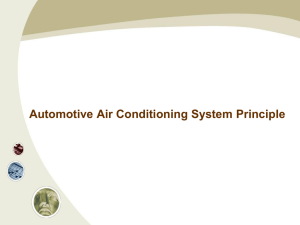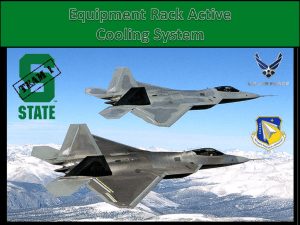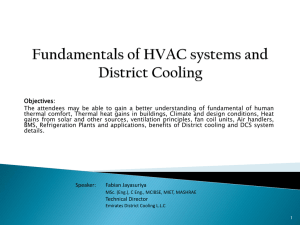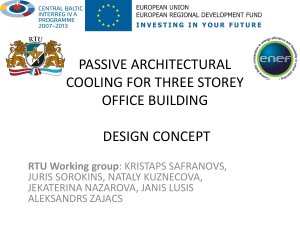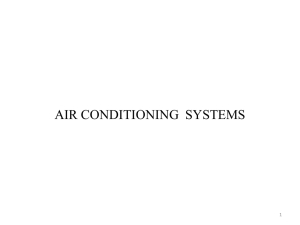Air conditioned
advertisement
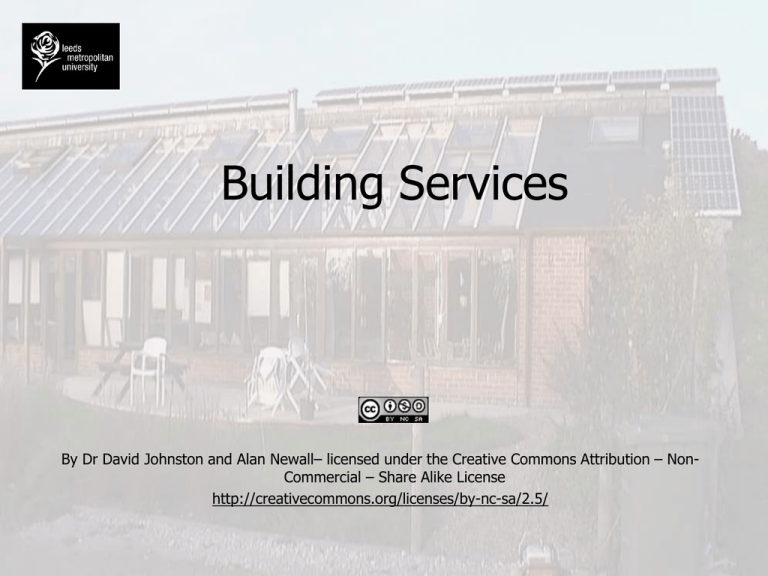
Building Services By Dr David Johnston and Alan Newall– licensed under the Creative Commons Attribution – NonCommercial – Share Alike License http://creativecommons.org/licenses/by-nc-sa/2.5/ ENVIRONMENTAL SCIENCE & SERVICES LEVEL 1 Air conditioning Alan Newall & Dr David Johnston Air conditioning The term”air conditioning” is commonly used to describe any system where refrigeration is included to provide cooling. Cooling may be required to: Provide a healthy and comfortable environment for the occupants. Preserve goods. Precisely control various industrial processes. A wide range of air conditioning systems are available. The various systems can be categorised according to their function: Full air conditioning systems - Provide all of the ventilation and fresh air requirements of the building and control both temperature and humidity within predetermined limits. The air supply is filtered, heated or cooled to the required temperature, and is humidified or dehumidified to maintain acceptable levels of relative humidity. Close control air conditioning systems - Similar to full systems, but are capable of maintaining temperature and relative humidity within close control limits, typically within ±0.5ºC and ±5% RH. Comfort cooling systems - Use refrigeration to reduce indoor temperatures when required to produce more comfortable conditions for occupants. Ventilation and fresh air are not always supplied from a comfort cooling system, and may need to be provided separately. Air conditioning Air conditioning systems do not have to be applied to a whole building. They can be applied to specific areas of a building in order to provide a healthy and comfortable environment for the building occupants. The building can incorporate: Full air conditioning - Where all parts of the building are treated, except for toilets, staircases and utility or storage areas. Partial air conditioning - Where only certain specific areas of the building are treated. Mixed-mode system - Where parts or all of the building are provided with air conditioning for use at times when natural ventilation or mechanical ventilation alone are insufficient (e.g. summer peak conditions). (MoD, 1996) The use of partial or mixed-mode systems instead of a full air conditioning system can reduce capital installation and operating costs. Energy and environmental cost of air conditioning Air conditioned buildings have previously consumed 1½ to 2 times as much energy as an equivalent naturally ventilated building (MoD, 1996), resulting in an increase in CO2 emissons. Introducing full air conditioning into a design can often add significantly to the eventual running costs of the building (CIBSE, 1998). Air conditioned buildings are more complex and costly to build and maintain. In the UK, there is a limited set of circumstances in which a building will require air conditioning. It can be necessary in certain circumstances due to pollution, external noise and high heat gains (CIBSE, 1998). Climate change is leading to increased heat gains and peak summertime temperatures, which is in turn increasing the demand for air conditioned buildings. In a large number of buildings, full mechanical air conditioning is not always necessary and large savings can be made by using mechanical or natural ventilation. Building heat gains Air conditioning systems are normally specified to prevent overheating of certain buildings in summer. Buildings suffer heat gains from a number of sources, predominantly: Solar heat gain through glazing. Internal heat gains from: - People. - Lighting. - Equipment. Ventilation from warm outside air. These heat gains peak in summer and must be offset by the air conditioning system to maintain thermal comfort conditions. Determining the need for air conditioning The figure below provides useful guidance in assessing the need for full air conditioning, comfort cooling or mechanical ventilation. What are your requirements [Source: BRECSU, 1993] Types of air conditioning system There are three generic types of air conditioning system: Centralised all-air systems - Air is heated or cooled in a central plant room and is then distributed to the rooms via ductwork. Partially centralised air/water systems - Air may be heated or cooled in a central plant room and is then further heated or cooled at entry to the rooms. Local systems (self-contained) - All of the operations are performed locally. Many local systems provide comfort cooling only. Other functions such as fresh air supply, humidity control and heating are often not available. Centralised all-air systems These systems are typically based around a packaged air handling unit (AHU) which consists of a fan, combinations of heating and cooling coils, filters,humidifiers and control dampers. They may also include the facility to recycle exhaust air back into the building. AHU [Source: Flakt Woods, 2003] The AHU would be located within a plant room with chillers and boilers located nearby, which supply hot and cold water to the heater battery and cooling coil. Centralised all-air systems These comprise: Constant volume single zone systems. Variable air volume (VAV) systems. Constant volume single zone systems Heating and cooling loads are met by changing the temperature of the supply air. A constant volume air supply at a single temperature is delivered to all areas of the building. Humidification may be provided in winter by a steam humidifier, included within the air handling unit. Separate systems may be required to serve different zones, increasing capital costs and plant room space. These systems are simple, relatively low cost and easy to commission, but they cannot provide adequate control for zones which have different heating or cooling needs. The system is suitable for large factory spaces, supermarkets and assembly halls. Centralised all-air systems Single duct variable air conditioning system [Source: Chadderton, 1993]. Centralised all-air systems Variable air volume (VAV) system The VAV system overcomes some of the problems associated with zones which have different heating or cooling needs. They provide zone control of the temperature from the central plant. Humidity is still controlled centrally and therefore humidity conditions may vary widely between different zones. Air is supplied at constant temperature and relative humidity to all parts of the building. Different cooling requirements are achieved by varying the volume of air supplied to each zone from the central plant. Control of the air volume is performed by a thermostatically controlled damper box (VAV box), which is fitted in the air supply ducts. Heating is provided either by a separate heating system or by providing reheat coils in each VAV box. The air flow rate may be controlled by an energy efficient variable speed fan. VAV systems can be energy efficient and are common in new open plan buildings. Centralised all-air systems Fan-powered variable air volume terminal unit installed in a false ceiling [Source: Chadderton, 1993]. Centralised all-air systems Variable air volume (VAV) system VAV unit [Source: Barcol-air, 2003] VAV terminal unit [Source: Hassan, 1996] Partially centralised air/water systems The common factor with these systems is that a central AHU is used, with the air being further heated or cooled to the individual room requirements by additional heating or cooling coils. Partially centralised systems generally consist of: Centralised air systems with re-heat. Fan coil unit systems. Chilled ceilings/beams. Unitary reversible heat pumps. Partially centralised air/water systems Centralised air systems with re-heat Both constant volume and VAV systems are available. In constant volume systems this greatly improves controllability and the ductwork can be configured to serve zones with quite different heating and cooling requirements (referred to as Constant volume multi-zone systems). Heating coils which provide reheat are normally located in ductwork within ceiling voids serving each zone (partially centralised system). In VAV systems reheating coils are provided located within the VAV box (VAV with reheat). This has the disadvantage that hot water must be piped to the VAV boxes and there is some potential for leaks within the occupied areas. An advantage of a VAV with reheat system is that reheat need only be applied to the VAV boxes where heating needs are greatest. These systems, which first cool and then reheat the supply air, are often responsible for excessive energy use in air conditioned buildings. Partially centralised air/water systems Fan coil unit systems Fan coil units are similar to fan convector heaters. The major difference is that chilled water is fed to the units in summer, as well as hot water in winter. Fan coil units have two coils in each unit, supplied with hot and cold water from a central boiler and refrigeration plant (4-pipe system). Fan coil units provide a flexible comfort cooling system most commonly used in multi-zone buildings, e.g. hotels and cellular offices. Fan coil unit systems Each room (or zone) is provided with a fan coil unit, located within a suspended ceiling or floor mounted. The units recirculate heated or cooled room air and can introduce fresh air to maintain air quality. Air filtration can be included. Fresh air may be provided from a separate system, ducted to the inlet of the fan coil unit, or supplied directly to the space. Fan coil systems can provide multi-zone control of temperature without the need for reheat, and can cope with situations where simultaneous heating and cooling may be required. Fan-coil unit air conditioning system (SDFC) [Source: Chadderton, 1993]. Chilled ceilings/beams Conventional air conditioning systems provide cooling almost entirely by convective heat transfer. Cooling can also be provided by a combination of radiation and convection. This can be achieved using chilled ceilings and/or beams. Chilled ceiling/beams use chilled or cooled water (normally between 13 to 18°C) as the cooling medium (CIBSE, 2001). “Free cooling” may be utilised if a suitable source of groundwater is available. There are three generic types of chilled ceiling/beams: Radiant ceiling panels - Cooling is principally achieved via the process of radiant exchange. Typically, 60% of the cooling output is achieved through this heat transfer mechanism. Serpentine chilled water pipework is incorporated within the ceiling panels. Passive chilled beams - Cooling is achieved by natural convection, by passing chilled water through finned elements (similar in form to a heat exchanger). The beams can be installed flush with most false ceilings or can be fully exposed in aesthetic casings. Active chilled beams - Similar to passive chilled beams, except that the air moving through the beam is mechanically assisted. The air is supplied to the room through diffusers built into the beam. Chilled ceilings/beams Chilled ceiling panels [Source: SAS, 2003] Chilled beams [Source: SAS, 2003] Chilled ceilings/beams Chilled ceilings and beams only provide comfort cooling. Filtration, heating and humidification are not available. With active chilled beams ventilation is provided from the central plant, and filtration may be provided. With passive chilled beams and ceiling panels, ventilation has to be introduced separately. This is normally achieved by displacement ventilation. The avoidance of condensation on the surface of chilled beams and ceilings has been a major design issue in the UK (CIBSE, 2001). Chilled ceilings and beams must be controlled to prevent the risk of condensation, otherwise ‘office rain’ could occur. This can be achieved by incorporating condensation detection into the chilled beam control system. Partially centralised air/water systems Unitary reversible heat pumps Heating or cooling is provided from a constant temperature water (two pipe) loop. The water loop is heated or cooled according to demand, in a central plant room by means of a boiler and central refrigeration plant. Advantageous if several zones of a building require significantly different temperature conditions, or if there is a need for simultaneous heating and cooling in different zones. A separate ventilation system is normally required to maintain indoor air quality. Calorex heat pumps [Source: Calorex, 2003] Local systems Local systems normally only provide comfort cooling, although filtration and heating can also be provided. Humidification is not normally available. They are often used as a refurbishment option. Local systems may be less effective than centralised plant but can provide energy savings through reduced distribution losses, simpler heat rejection equipment, greater control over operating periods, and their ability to be more readily confined to the areas of greatest need (CIBSE Guide B2), e.g. partial air conditioning. Local systems generally consist of: Through-the-wall packaged units. Split packaged units. Variable refrigerant flow units. Local systems Through-the-wall packaged units – small scale domestic/commercial application providing comfort cooling Generally consist of a small refrigeration unit with an integral air circulation fan. Air is drawn from the room, cooled and returned. They require wall mounting, can be noisy and are generally not very efficient. Some units offer heating by electric resistance heaters which can be expensive to run. Maintenance is carried out in situ, which could be difficult and expensive if there are a large number of units. Single duct packaged unit [Source: Greeno, 1997] Local systems Split packaged units Divided into two components: the indoor fan coil unit. This contains a filter, a fan, an evaporator coil and the expansion or regulating valve. the outdoor refrigeration unit. This contains the condenser coil, a fan and a compressor. The units are connected to each other directly by pipes containing the refrigerant gas/liquid. Multi-split packaged units are available, where one outdoor unit can service several indoor units (around 6 to 8). Noise problems can be avoided in the space since the noisy condenser and compressor are located outside and can be detached from the occupied area of the building. Multi-split packaged unit [Source: Daikin, 2003] Local systems Variable refrigerant flow units – alternative system to fan coil units. A special type of multi-split system where the refrigerant flow rate can be controlled to match the cooling load through a variable speed compressor. Most systems act as heat pumps and can switch between heating and cooling modes. Most advanced systems allow the heat removed from areas that require cooling to be supplied to areas that require heating. This results in energy savings. Maintenance costs can be relatively high. Variable refrigerant flow system [Source: Daikin, 2003] Air conditioning considerations Fundamental to the design of air conditioning systems are the following considerations: Systems which rely entirely on ducted air to distribute heat are bulky because air has a low specific heat capacity and high volumes are required. Water provides a very compact medium for heat distribution, but water circuits may leak and must therefore be separated from electrical systems. Refrigerants themselves provide an effective distribution system in most local systems. Systems which condition large areas from central plant minimise the number of some components but involve bulkier distribution systems, and may make separate control of different zones within a building more difficult. Local/decentralised systems facilitate zone control and reduce or eliminate distribution systems. They may impose higher maintenance costs due to the large number of separate heating systems and chillers involved. Refrigeration systems Refrigeration equipment is used to chill air or water in all mechanical air conditioning systems. There are two types of system commonly in use: Vapour compression type. The absorption type. In the UK, a mechanical vapour compression system is generally used, although absorption refrigeration systems should be considered where waste heat is available (e.g. from CHP). Refrigeration systems Vapour compression system (Electrical) Compression refrigerator cycle [Source: McMullan, 1998] Stage A - Liquid refrigerant evaporates at a low temperature, absorbing heat and providing cooling. Stage B - The pressure of the refrigerant vapour is increased by means of a compressor. The pressurisation raises the temperature of the refrigerant and requires an input of energy into the system. Stage C - The refrigerant vapour condenses. The latent heat released is emitted by the condenser to the surrounding air. Stage D - The liquid refrigerant is passed through an expansion valve and its temperature and pressure drops for a repeat of the cycle. Coefficient of performance The efficiency of a vapour compression system is expressed as a Coefficient of Performance (C.o.P.), where: C.o.P, (cooling) = Heat absorbed by the evaporator (cooling provided) Electrical energy used by the compressor Refrigeration plant should be selected with as high a possible C.o.P. to minimise the environmental impact of the air conditioning system. Typical values of C.o.P. (cooling) are between 2 to 3.0. Heat pump technology Heat pumps use the vapour compression cycle to provide both heating and cooling for a building as required. In winter, when heating is required, the functions of the evaporator and the condenser are reversed. The evaporator absorbs low grade heat from a low temperature source and high grade heat (at around 40 to 50°C) is released to the building from the condenser. Heat pump technology Heat sources for heat pumps include ambient air, and the ground, where buried coils are used to extract low grade heat effectively. Heat pumps perform well with low temperature heating systems, e.g. warm air or underfloor heating. For heating the C.o.P. is defined as: C.o.P, (heating) = Heat supplied to the building Electrical energy used by the compressor C.o.P.’s of around 4 to 5.0 can be achieved using ground source heat pumps, which provides a significant reduction in environmental impact, relative to conventional heating systems. Refrigeration systems Absorption system – used where a source of waste heat is available, e.g. from CHP systems. (Waste heat from process/CHP) Absorption refrigerator cycle [Source: McMullan, 1998] Stage A - The evaporator coils are placed in the low temperature heat source and heat is absorbed by the evaporating refrigerant. Stage B - The temperature of the refrigerant and water solution is increased, separating the refrigerant from the water. Stage C - The refrigerant vapour is cooled and condensed to a liquid, releasing heat. Stage D - The refrigerant is expanded and it evaporates for a repeat of the cycle. Selection of refrigeration systems There are a number of key issues which need to be addressed when selecting refrigeration equipment. These are: Can a refrigeration plant be avoided, or can its use be limited by using a ‘free cooling’ technique (e.g. outside air or groundwater). If a refrigeration plant is necessary, then it must be efficient. The difference between the running costs of a good and bad system can be as much as 50%. References BARCOL-AIR (2003) Variable Air Volume Systems (VAV). Available from:< http://www.barcol-air.co.uk/variable_air-index.htm > [Accessed February 18th 2003]. BRECSU (1993) Selecting Air Conditioning Systems. Good Practice Guide 71. Department of the Environment, London, HMSO. CALOREX (2003) Calorex Heat Pumps. Available from:< http://www.calorex.com/ > [Accessed February 19th 2003]. CHADDERTON, D. (1993) Air Conditioning – A Practical Introduction. E & FN Spon. CIBSE (2001) Ventilation and Air Conditioning: CIBSE Guide B2. London, Chartered Institute of Building Services Engineers. CIBSE (1998) Energy Efficiency in Buildings: CIBSE Guide. London, Chartered Institute of Building Services Engineers. DAIKIN (2003) Daikin Industries Ltd. Available from:< http://global.daikin.com/ > [Accessed February 19th 2003]. FLAKT WOODS (2003) Air Handling Unit EC 2000. Available from:< http://www.flaktwoods.com/ standard/sitemanagerview.aspx?strSiteID=60&strLanguageID=1&strMenuID=23&strModuleObje ct=&strModuleID=&strResourceID=> [Accessed February 18th 2003]. References (continued) GREENO, R. (1997) Building Services, Technology and Design. Harlow, UK, Addison Wesley Longman Limited. HASSAN, G. (1996) Building Services. London, UK, MacMillan Press Ltd. MoD (1996) Justifying the Provision of Air Conditioning. Defence Works Function Standard Design and Maintenance Guide 07, Ministry of Defence, London, HMSO. SAS (2003) SAS International Chilled Ceilings. Available from:< http://www.sasint.co.uk/index.html > [Accessed February 19th 2003].

